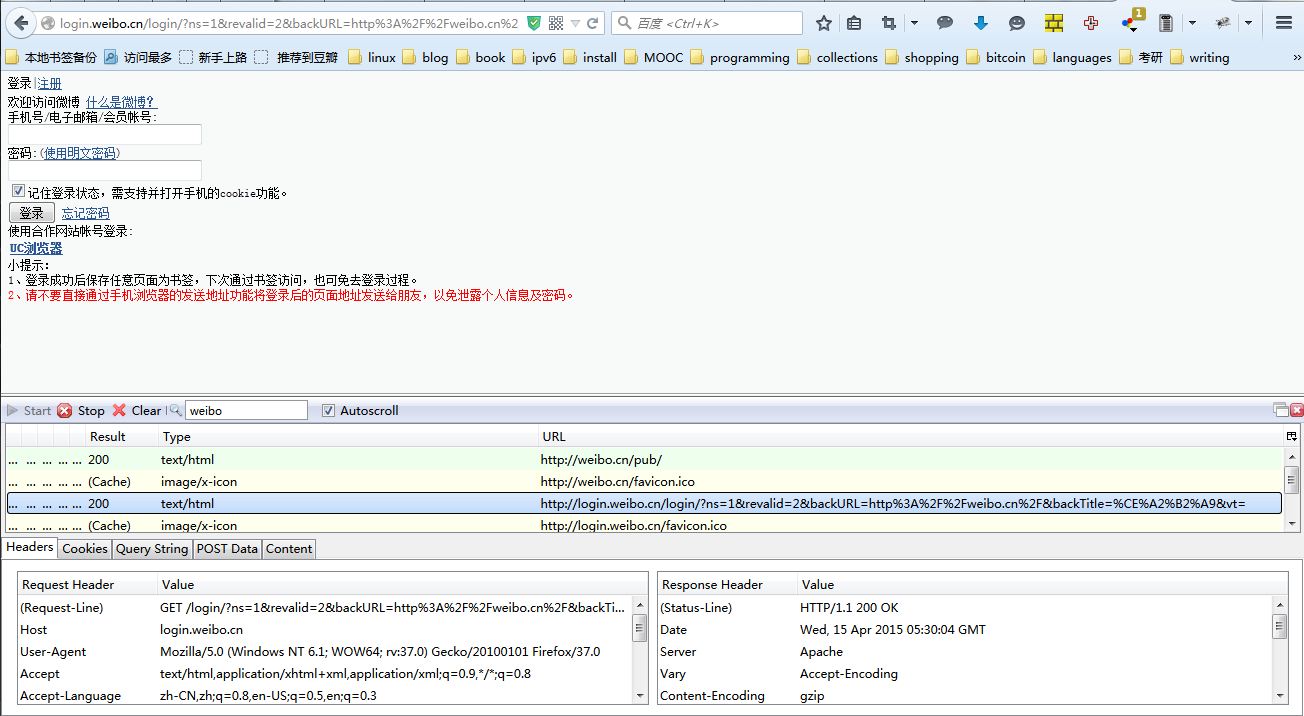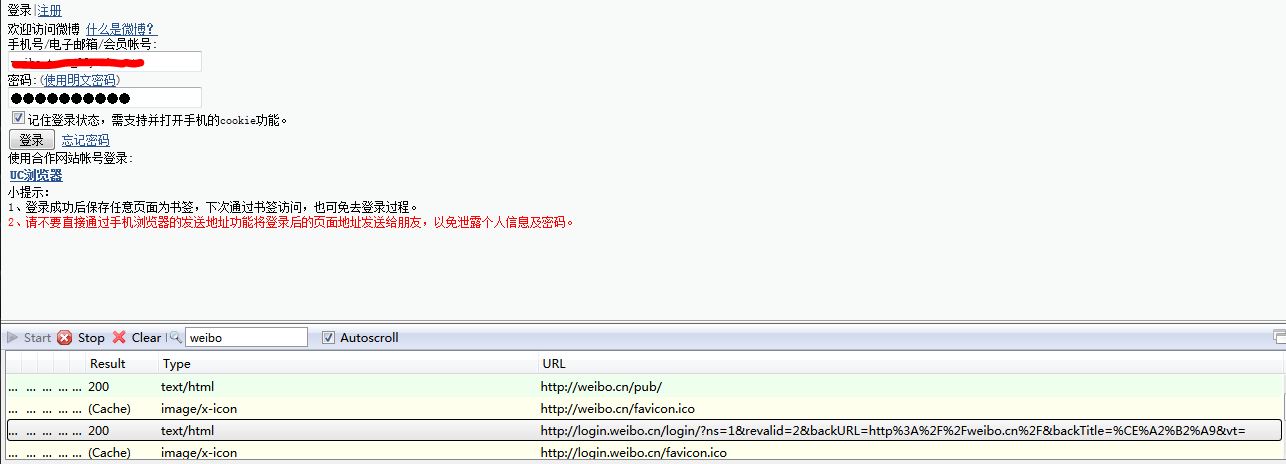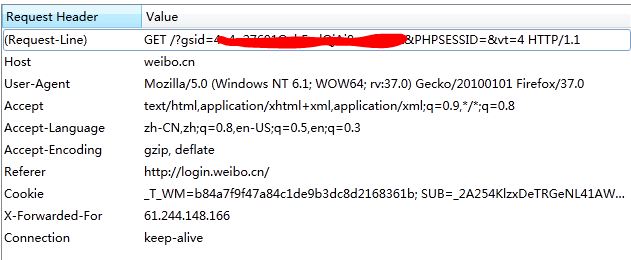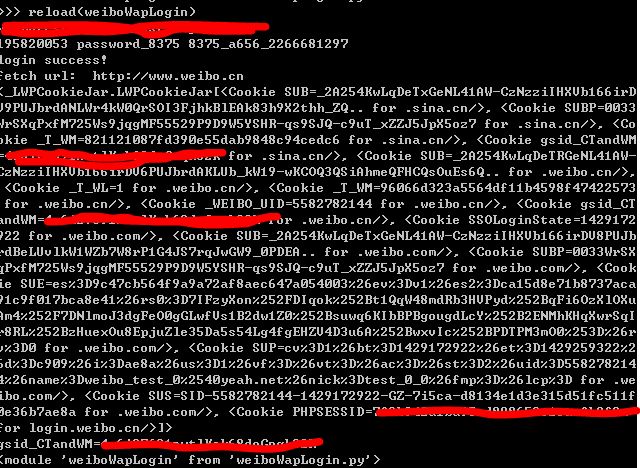新浪微博爬取笔记(2):wap端模拟登陆 python
===================
看了其他人的博客都写的很简洁干净,我这边的排版简直要晕。图和代码一起上,小白每一步都要有讲解。。。
===================
虽然weibo.com的模拟登陆用http://www.cnblogs.com/houkai/p/3487816.html的代码成功了,但是新版微博的标签太复杂,而且爬取一个用户的微博列表的时候,最底端是“正在加载”,不好模拟。因此改爬weibo.cn。
除此之外,weibo.cn比weibo.com更适合爬取的原因还有:
1、weibo.cn的模拟登陆步骤比weibo.com要简单;
2、微博列表是分页显示,目前每页有5条;
3、评论,转发列表都是静态加载。
先进行模拟登陆。模拟登陆有两种方法,在pc端操作:
1、user-agent用UC浏览器,模仿手机端,如http://blog.csdn.net/zhaolina004/article/details/28699095,步骤简单。需要注意的是,虽然在手机端可以采用保存登陆后页面即保存cookie下次直接登陆的方式,pc端则不行。
####15年4月 登陆后地址变为http://weibo.cn/?vt=4 不再显示gsid (事实上显示gsid的网址重定向到weibo.cn/?vt=4,以下截图中会显示,直接访问并不能进入登陆页面,用UC也不行)
####放弃
2、user-agent用Firefox浏览器,如http://qinxuye.me/article/simulate-weibo-login-in-python/,这篇是12年的文章,现在是15年4月,登陆页面地址和请求数据等都发生了改变,需要做一些修改。
=====================================================
试一下方法2, 边做边写:
原始代码来自http://qinxuye.me/article/simulate-weibo-login-in-python/,现粘贴到下方:
1 import urllib2 2 import urllib 3 import cookielib 4 5 import lxml.html as HTML 6 7 class Fetcher(object): 8 def __init__(self, username=None, pwd=None, cookie_filename=None): 9 self.cj = cookielib.LWPCookieJar() 10 if cookie_filename is not None: 11 self.cj.load(cookie_filename) 12 self.cookie_processor = urllib2.HTTPCookieProcessor(self.cj) 13 self.opener = urllib2.build_opener(self.cookie_processor, urllib2.HTTPHandler) 14 urllib2.install_opener(self.opener) 15 16 self.username = username 17 self.pwd = pwd 18 self.headers = {'User-Agent':'Mozilla/5.0 (Windows NT 6.1; rv:14.0) Gecko/20100101 Firefox/14.0.1', 19 'Referer':'','Content-Type':'application/x-www-form-urlencoded'} 20 21 def get_rand(self, url): 22 headers = {'User-Agent':'Mozilla/5.0 (Windows;U;Windows NT 5.1;zh-CN;rv:1.9.2.9)Gecko/20100824 Firefox/3.6.9', 23 'Referer':''} 24 req = urllib2.Request(url ,urllib.urlencode({}), headers) 25 resp = urllib2.urlopen(req) 26 login_page = resp.read() 27 rand = HTML.fromstring(login_page).xpath("//form/@action")[0] 28 passwd = HTML.fromstring(login_page).xpath("//input[@type='password']/@name")[0] 29 vk = HTML.fromstring(login_page).xpath("//input[@name='vk']/@value")[0] 30 return rand, passwd, vk 31 32 def login(self, username=None, pwd=None, cookie_filename=None): 33 if self.username is None or self.pwd is None: 34 self.username = username 35 self.pwd = pwd 36 assert self.username is not None and self.pwd is not None 37 38 url = 'http://3g.sina.com.cn/prog/wapsite/sso/login.php?ns=1&revalid=2&backURL=http%3A%2F%2Fweibo.cn%2F&backTitle=%D0%C2%C0%CB%CE%A2%B2%A9&vt=' 39 rand, passwd, vk = self.get_rand(url) 40 data = urllib.urlencode({'mobile': self.username, 41 passwd: self.pwd, 42 'remember': 'on', 43 'backURL': 'http://weibo.cn/', 44 'backTitle': '新浪微博', 45 'vk': vk, 46 'submit': '登录', 47 'encoding': 'utf-8'}) 48 url = 'http://3g.sina.com.cn/prog/wapsite/sso/' + rand 49 req = urllib2.Request(url, data, self.headers) 50 resp = urllib2.urlopen(req) 51 page = resp.read() 52 link = HTML.fromstring(page).xpath("//a/@href")[0] 53 if not link.startswith('http://'): link = 'http://weibo.cn/%s' % link 54 req = urllib2.Request(link, headers=self.headers) 55 urllib2.urlopen(req) 56 if cookie_filename is not None: 57 self.cj.save(filename=cookie_filename) 58 elif self.cj.filename is not None: 59 self.cj.save() 60 print 'login success!' 61 62 def fetch(self, url): 63 print 'fetch url: ', url 64 req = urllib2.Request(url, headers=self.headers) 65 return urllib2.urlopen(req).read()
看一下登录过程,用firefox的httpfox工具:
(1)进入登陆页面,得到url

对照代码中38,39行,需要改url为以上页面的url:
38 url = 'http://3g.sina.com.cn/prog/wapsite/sso/login.php?ns=1&revalid=2&backURL=http%3A%2F%2Fweibo.cn%2F&backTitle=%D0%C2%C0%CB%CE%A2%B2%A9&vt=' 39 rand, passwd, vk = self.get_rand(url)
再看一下39行用到的get_rand():
*从第7行开始按照代码,查找页面元素,可看到rand, passwd, vk这些值在哪里:
(注意这里的headers又被定义了一遍,而在_init_()中已经给定了self.headers,暂且注释掉,并且根据实际所用的firefox版本(以上页面Request Header中的user-agent项)改掉_init_中的self.headers.)
(这里得到的password不是用户密码,是登陆request需要提交数据项的名称,后面有解释)
1 def get_rand(self, url):##############get rand, see html page 2 #headers = {'User-Agent':'Mozilla/5.0 (Windows;U;Windows NT 5.1;zh-CN;rv:1.9.2.9)Gecko/20100824 Firefox/3.6.9', 3 # 'Referer':''} #####why different? 4 req = urllib2.Request(url ,urllib.urlencode({}), self.headers) 5 resp = urllib2.urlopen(req) 6 login_page = resp.read() 7 rand = HTML.fromstring(login_page).xpath("//form/@action")[0] 8 passwd = HTML.fromstring(login_page).xpath("//input[@type='password']/@name")[0] 9 vk = HTML.fromstring(login_page).xpath("//input[@name='vk']/@value")[0] 10 return rand, passwd, vk
输入用户名和密码:

输入用户名和密码之后,没有新的响应,说明新浪没有对这两个字段做加密处理,这是和微博pc端weibo.com不同的地方。
(2)提交post

可看到有4个重定向,和一个200的最终url。 其中第一个重定向是POST方法,其余的都是GET。
先看POST的重定向:
看一下原始代码的login()部分40到49行,
40 data = urllib.urlencode({'mobile': self.username,
41 passwd: self.pwd,
42 'remember': 'on',
43 'backURL': 'http://weibo.cn/',
44 'backTitle': '新浪微博',
45 'vk': vk,
46 'submit': '登录',
47 'encoding': 'utf-8'})
48 url = 'http://3g.sina.com.cn/prog/wapsite/sso/' + rand
49 req = urllib2.Request(url, data, self.headers)
(其中password的“:”前的部分是一个变量,原因在下一张截图中)
rand, password, vk字段都是在get_rand()时已经得到。看一下登陆request中需要的具体数据项data:

password后是一个“_”另加四位数字。这个数字不是固定的,这是我第二次访问,和第一次访问的数字已经不同了。所以在get_rand()中用变量存储password;
value部分有一些乱码。页面是utf-8编码的,把最下面的Pretty改成Raw显示得到utf-8编码的形式,整理一下:
1 mobile=******2 password_2854=******* ##这是上一次登陆的password名称3 remember=on 4 backURL=http%253A%252F%252Fweibo.cn 5 backTitle=%E6%89%8B%E6%9C%BA%E6%96%B0%E6%B5%AA%E7%BD%91 6 tryCount= 7 vk=2854_cfe0_1714426041 8 submit=%E7%99%BB%E5%BD%95
这些value值段的是utf-8编码后的形式。用网上的在线utf-8转换,得到的是和上图一样的乱码。。Anyway,那就直接用utf-8编码后的结果。
#############update 4.21############
说错了,这里不是utf-8编码,而是HTML转义序列的unicode解码, HTML转义序列参见http://www.zhihu.com/question/21390312的最高票回答;
%8B%E6%9C%BA%E6%96%用unicode编码之后成为“&#, &#”格式的HTML转义序列,character reference, "从 HTML 4 开始,NCR 以 Unicode 为准,与文档编码无关"。
网页编码是utf-8而不是报文编码。 我的火狐浏览器设置的编码也是utf-8,所以解析出来是乱码
#################################
用本地看到的POST data改一下原始代码中的data部分,同样也改一下POST请求的url:
1 data = urllib.urlencode({'mobile':self.username, 2 passwd :self.pwd, 3 'remember':'on', 4 'backURL':'http://weibo.cn/', 5 #'backTitle':u''.decode('utf-8').encode('utf-8'), 6 #'backTitle':'新浪微博', 7 'backTitle':'%E6%89%8B%E6%9C%BA%E6%96%B0%E6%B5%AA%E7%BD%91', 8 'tryCount':'', 9 'vk':vk, 10 #'submit':u''.decode('utf-8').encode('utf-8'), 11 #'submit':'登陆', 12 'submit':'%E7%99%BB%E5%BD%95'}) 13 url = 'http://login.weibo.cn/login/?' + rand + '&backURL=http%3A%2F%2Fweibo.cn%2F&backTitle=%E5%BE%AE%E5%8D%9A&vt=4&revalid=2&ns=1'
(原始代码定位元素用了lxml这个包。另一个方案是用BeautifulSoup。虽然lxml的速度据说比BeautifulSoup快10倍。。但是lxml安装比较麻烦。。所以先改为BeautifulSoup实现。)
(3)通过GET得到gsid,得到登陆url,重定向到最终url "weibo.cn/&vt=4"
再看GET带gsid的url的重定向到主页,看一下GET报文:

代码中这部分无法理解,新浪应该已经改了:
48 url = 'http://login.weibo.cn/' + rand 49 req = urllib2.Request(url, data, self.headers) 50 resp = urllib2.urlopen(req) 51 page = resp.read() 52 link = HTML.fromstring(page).xpath("//a/@href")[0] 53 if not link.startswith('http://'): link = 'http://weibo.cn/%s' % link 54 req = urllib2.Request(link, headers=self.headers)
如上上图,需要GET weibo.cn/ + gsid,gsid的值在cookie中,如图:

cookie中的gsid_CTandWT字段的值即是。是由weibo.cn存储的。
看一下四个重定向:

第一个login.weibo.cn里面没有这个cookie;第三个passport.weibo.com是weibo.com的,没有gsid;第二个和第四个里面有。但是gsid_CTandWM不是由第二个get产生的,因为第二个的报文中的cookie行里已经用了gsid。
那只能认为第一个的POST就得到了gsid值,虽然response报文里什么都没有(估计是对用户隐蔽吧)。
参考这篇文章http://blog.csdn.net/xiexieni057/article/details/16698787里处理cookie的方法:
1 #get an important cookie value gsid from cookiejar 2 try: 3 beginPos = str(self.cookie).index('gsid_CTandWM') 4 endPos = str(self.cookie).index('for', beginPos) 5 except Exception as e: 6 print e 7 if beginPos >= endPos: 8 print "cookie was changed by sina" 9 else: 10 cookie_value = str(self.cookie)[beginPos: endPos] 11 self.headers2 = {'User-Agent': 'Mozilla/5.0 (Windows NT 6.1; WOW64; rv:37.0) Gecko/20100101 Firefox/37.0', 12 'cookie': cookie_value} 13 #use gsid to login 14 req = urllib2.Request(url="http://weibo.cn", 15 data=urllib.urlencode({}), 16 headers=self.headers2) 17 urllib2.urlopen(req)
贴一下改完后的代码:
1 # -*- coding : utf-8 -*- 2 import re 3 import urllib2 4 import random 5 import urllib 6 import cookielib 7 import socket 8 9 #import lxml.html as HTML 10 from bs4 import BeautifulSoup 11 12 class Fetcher(object): 13 def __init__(self, iplist=[], username=None, pwd=None, cookie_filename=None): 14 if iplist != []: 15 self.iplist = iplist 16 proxy_ip = random.choice(self.iplist) 17 self.proxy_handler = urllib2.ProxyHandler({'http': 'http://' + proxy_ip}) 18 else: 19 self.proxy_handler = urllib2.ProxyHandler() 20 21 self.cj = cookielib.LWPCookieJar() 22 ##cookie jar, use self.cj to restore the cookies generated in the process 23 if cookie_filename is not None: 24 self.cj.load(cookie_filename) 25 self.cookie_processor = urllib2.HTTPCookieProcessor(self.cj) 26 self.opener = urllib2.build_opener(self.cookie_processor, urllib2.HTTPHandler, self.proxy_handler) 27 urllib2.install_opener(self.opener) 28 #urllib2 set environment(?) 29 30 self.username = username # 31 self.pwd = pwd # 32 self.headers = {'User-Agent':'Mozilla/5.0 (Windows NT 6.1; WOW64; rv:37.0) Gecko/20100101 Firefox/37.0', 33 'Referer':'', 'Content-Type':'application/x-www-form-urlencoded'} 34 35 def get_rand(self, url):##############get rand, see html page 36 req = urllib2.Request(url ,urllib.urlencode({}), self.headers) 37 resp = urllib2.urlopen(req, timeout = 10) 38 login_page = resp.read() 39 soup = BeautifulSoup(login_page) ####need fix? 40 rand = soup.form['action'][6:15] 41 passwd = soup.find_all('input', attrs = {"type":"password"})[0]['name'] 42 vk = soup.find_all('input', attrs = {"name":"vk"})[0]['value'] 43 print rand, passwd, vk 44 return rand, passwd, vk 45 46 def login(self, username=None, pwd=None, cookie_filename=None): 47 if self.username is None or self.pwd is None: 48 self.username = username 49 self.pwd = pwd 50 assert self.username is not None and self.pwd is not None 51 print self.pwd, self.username 52 53 url = 'http://login.weibo.cn/login/?ns=1&revalid=2&backURL=http%3A%2F%2Fweibo.cn%2F&backTitle=%CE%A2%B2%A9&vt=' #use this url to get rand 54 rand, passwd, vk = self.get_rand(url) ###sucess 55 data = urllib.urlencode({'mobile':self.username, 56 passwd :self.pwd, 57 'remember':'on', 58 'backURL':'http://weibo.cn/', 59 'backTitle':'%E6%89%8B%E6%9C%BA%E6%96%B0%E6%B5%AA%E7%BD%91', 60 'tryCount':'', 61 'vk':vk, 62 'submit':'%E7%99%BB%E5%BD%95'}) 63 url = 'http://login.weibo.cn/login/?' + rand + '&backURL=http%3A%2F%2Fweibo.cn%2F&backTitle=%E5%BE%AE%E5%8D%9A&vt=4&revalid=2&ns=1' 64 resp = urllib2.urlopen(req, timeout = 10) 65 66 #get gsid from cookie 67 beginPos = str(self.cj).index('gsid_CTandWM') 68 endPos = str(self.cj).index('for', beginPos) 69 if beginPos >= endPos: 70 print "cookie was changed by sina" 71 else: 72 self.cookie_value = str(self.cj)[beginPos: endPos] 73 self.headers2 = {'User-Agent': 'Mozilla/5.0 (Windows NT 6.1; WOW64; rv:37.0) Gecko/20100101 Firefox/37.0', 74 'cookie': self.cookie_value} 75 76 req = urllib2.Request(url="http://weibo.cn", 77 data=urllib.urlencode({}), 78 headers=self.headers2) 79 urllib2.urlopen(req, timeout = 10) 80 81 #save cookie 82 if cookie_filename is not None: 83 self.cj.save(filename=cookie_filename) 84 elif self.cj.filename is not None: 85 self.cj.save() 86 print 'login success!' 87 88 def fetch(self, url): 89 print 'fetch url: ', url 90 req = urllib2.Request(url, headers=self.headers) #specify the headers parameter 91 return urllib2.urlopen(req, timeout = 10).read() 92
============================================================================
需要改的部分基本就完成了。现在测试:

加了两个print语句,分别打印最终得到的cookie和gsid值。能看到成功了!访问weibo.cn,并将网页内容打印到文件,也是主页的状态。
总结:
1、POST要求的data部分,没有写中文(因为是乱码),而是按照raw格式显示的内容原样粘贴上去。
2、最后测试出现问题的都是细节,比如GET要求的语句格式啊,data格式啊,要对自己有信心。。


 浙公网安备 33010602011771号
浙公网安备 33010602011771号